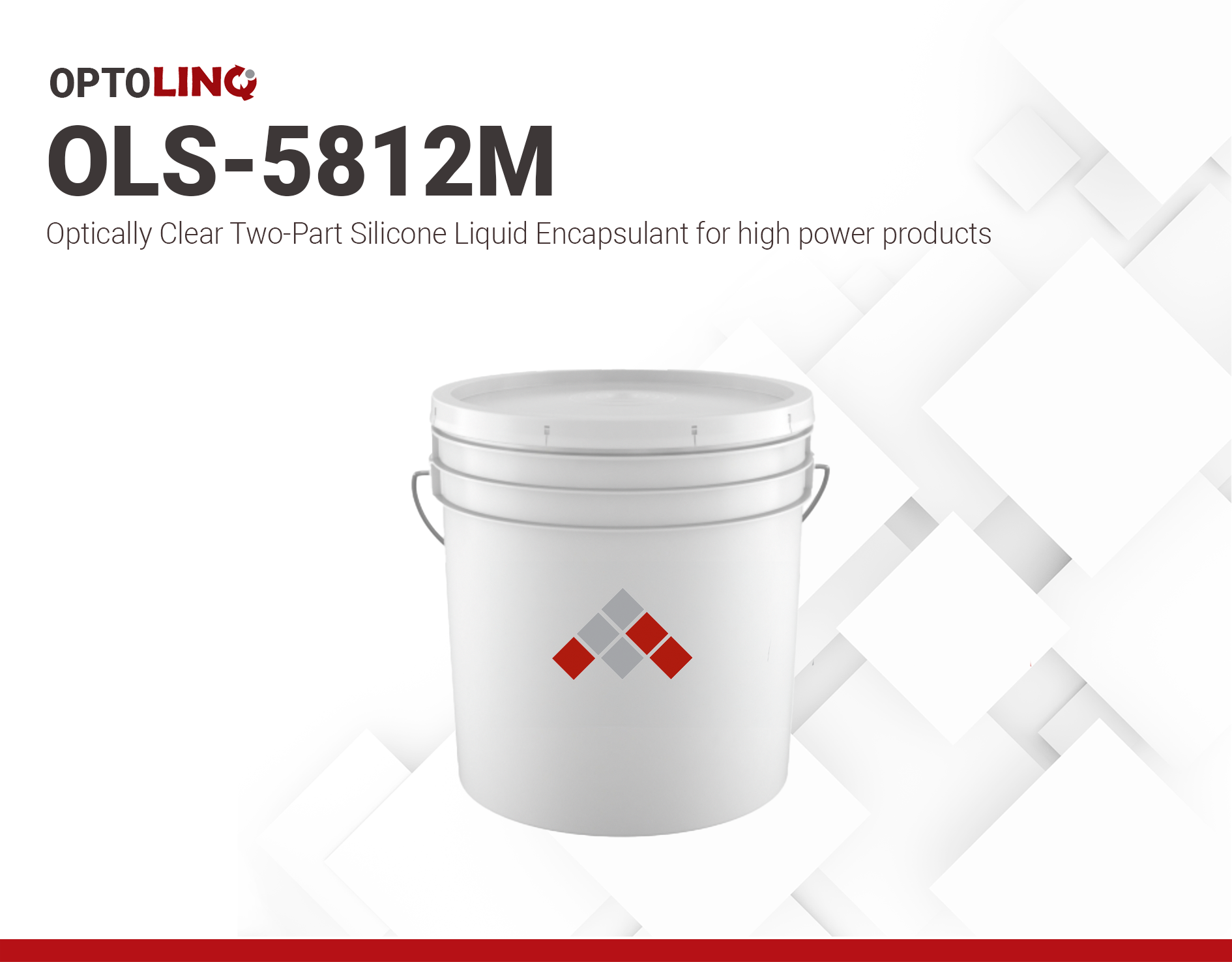OPTOLINQ OLS-5812M | Liquid encapsulant - Two part silicone
- High reliability
- Excellent thermal and light resistance
- Excellent adhesion to different materials
Product Description
OPTOLINQ OLS-5812M is a two-part silicone encapsulant designed for the encapsulation of high-power LED products. Engineered with a focus on enhancing thermal stabilities, OLS-5812M contains less low molecular weight substances, considerably improving its heat resistance and adhesion strength. It also contains additives like antioxidants, which retards thermo-oxidative aging and prolongs the product lifespan.
OLS-5812M offers good process compatibility. It is an ideal choice for industries seeking reliability, peak performance, and processability.
Technical Specifications
| General Properties | |||||
| Mix Ratio Mix Ratio The amount of a constituent divided by the total amount of all other constituents in a mixture | 1:4 | ||||
| Pot Life Pot Life Pot life is the amount of time it takes for the viscosity of a material to double (or quadruple for lower viscosity materials) in room temperature after a material is mixed. It is closely related to work life but it is not application dependent, less precise and more of a general indication of how fast a system is going to cure. | 4 hours | ||||
| Refractive index Refractive index The refractive index determines how much the path of light is bent, or refracted, when entering a material. It is calculated by taking into account the velocity of light in vacuum compared to the velocity of light in the material. The refractive index calculation can be affected by the wavelength of light and the temperature of the material. Even though it is usually reported on standard wavelengths it is advised to check the TDS for the precise test parameters. | 1.53 | ||||
| Physical Properties | |||||
| Viscosity Viscosity Viscosity is a measurement of a fluid’s resistance to flow. Viscosity is commonly measured in centiPoise (cP). One cP is defined as the viscosity of water and all other viscosities are derived from this base. MPa is another common unit with a 1:1 conversion to cP. A product like honey would have a much higher viscosity -around 10,000 cPs- compared to water. As a result, honey would flow much slower out of a tipped glass than water would. The viscosity of a material can be decreased with an increase in temperature in order to better suit an application | 2500 mPa.s | ||||
| Mechanical Properties | |||||
| |||||
| Electrical Properties | |||||
| Visible Light Transmission | >95 % | ||||
| Thermal Properties | |||||
| Temperature Resistance Temperature Resistance Temperature resistance is the maximum temperature that the material or product can withstand for a period of time. The temperatures listed should be considered as guidelines for an operating temperature of about 30 minutes. Typically, the material can withstand much longer times at temperatures about 20°C lower and can withstand much higher temperatures for short, intermittent times. | -55 to 200 ˚C | ||||
Additional Information
Processing Instructions
- Mix Parts A and B in a 1:4 weight ratio. Ensure that the mixture is uniform and free from streaks or unevenness.
- If air bubbles are entrapped during mixing, degas the mixture under vacuum.
- Typical curing conditions: First cure at 125 °C for 5 min, followed by post cure at 150 °C for 180 min.
Precautions
- Addition-cure materials may be susceptible to inhibition by certain substances, including organotin and other organometallic compounds, silicone rubber with organotin catalyst, sulfur-containing materials such as polysulfones, amines, urethanes, amine-containing materials, unsaturated hydrocarbon plasticizers, and some solder flux residues. Always exercise caution and conduct thorough compatibility testing when encountering materials or chemicals of concern in your specific application to prevent potential curing issues.
- Avoid skin and eye contact. In case of contact, rinse thoroughly with soap (for skin) or clean water (for eyes), and seek medical attention if needed.
- Maintain a clean and ventilated workplace, using extraction trunks when necessary.
- Wear appropriate protective equipment and minimize direct contact with the human body. Refer to the Material Safety Data Sheet (SDS) before use.
Cleaning
Uncured silicone can be easily removed using common hydrocarbon solvents, such as toluene and hexane. Polar solvents, including water and alcohols, are not recommended for this application.
Storage and Handling
Store in a ventilated, dry, and clean environment below 25°C. Do not allow moisture to come into contact with these materials. Containers should always remain tightly sealed. n the case of partially filled containers, it is recommended to purge them with dry air or inert gases like nitrogen to maintain product integrity. At proper storage conditions, Part A and B have a shelf life of 6 months.




